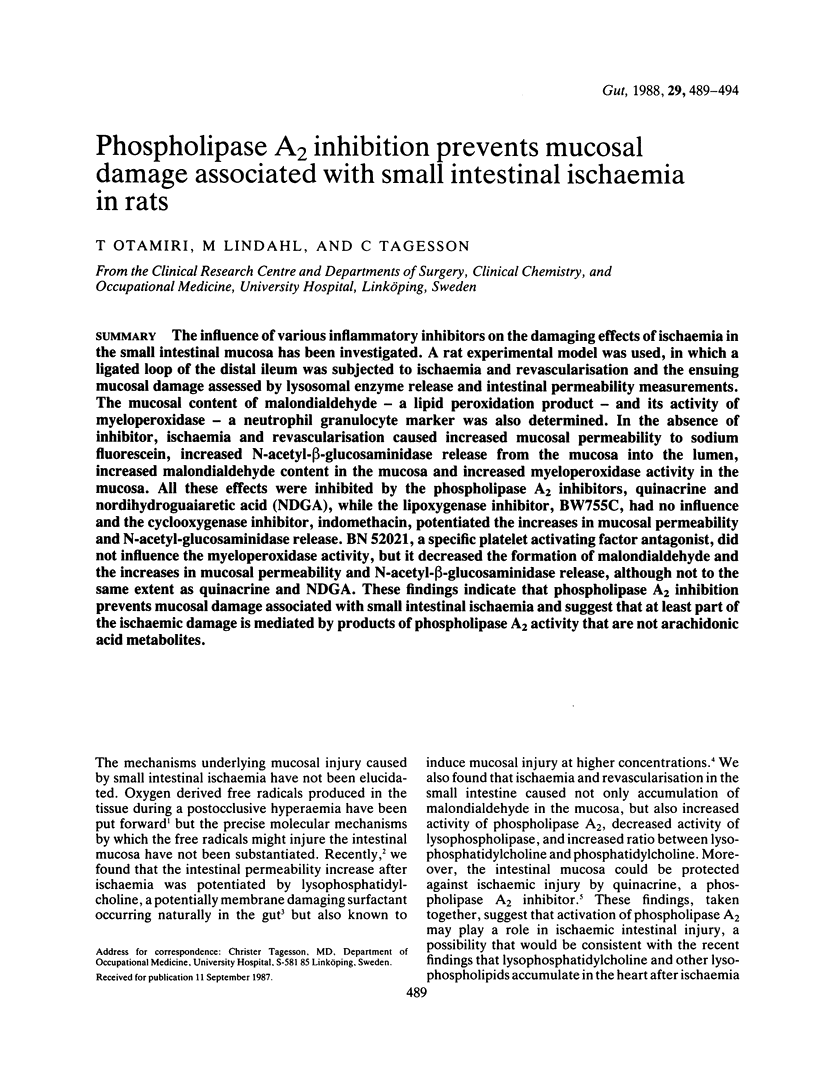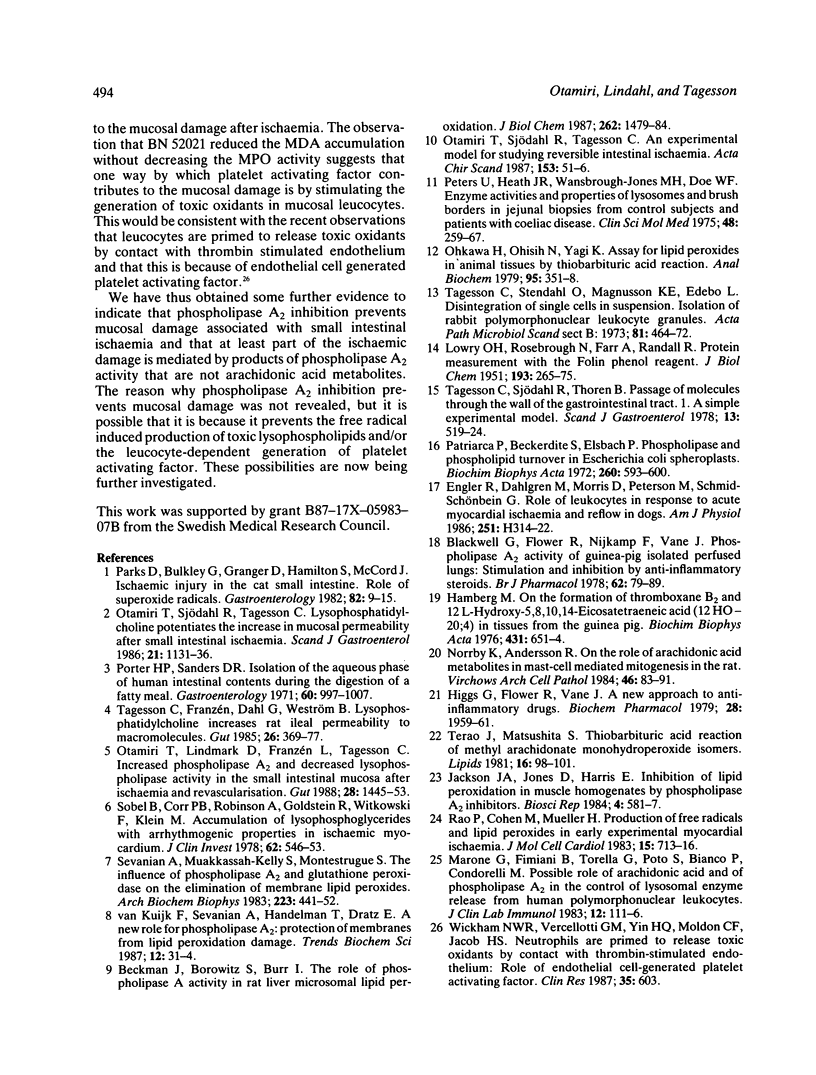Abstract
The influence of various inflammatory inhibitors on the damaging effects of ischaemia in the small intestinal mucosa has been investigated. A rat experimental model was used, in which a ligated loop of the distal ileum was subjected to ischaemia and revascularisation and the ensuing mucosal damage assessed by lysosomal enzyme release and intestinal permeability measurements. The mucosal content of malondialdehyde - a lipid peroxidation product - and its activity of myeloperoxidase - a neutrophil granulocyte marker was also determined. In the absence of inhibitor, ischaemia and revascularisation caused increased mucosal permeability to sodium fluorescein, increased N-acetyl-beta-glucosaminidase release from the mucosa into the lumen, increased malondialdehyde content in the mucosa and increased myeloperoxidase activity in the mucosa. All these effects were inhibited by the phospholipase A2 inhibitors, quinacrine and nordihydroguaiaretic acid (NDGA), while the lipoxygenase inhibitor, BW755C, had no influence and the cyclooxygenase inhibitor, indomethacin, potentiated the increases in mucosal permeability and N-acetyl-glucosaminidase release. BN 52021, a specific platelet activating factor antagonist, did not influence the myeloperoxidase activity, but it decreased the formation of malondialdehyde and the increases in mucosal permeability and N-acetyl-beta-glucosaminidase release, although not to the same extent as quinacrine and NDGA. These findings indicate that phospholipase A2 inhibition prevents mucosal damage associated with small intestinal ischaemia and suggest that at least part of the ischaemic damage is mediated by products of phospholipase A2 activity that are not arachidonic acid metabolites.
Full text
PDF





Selected References
These references are in PubMed. This may not be the complete list of references from this article.
- Beckman J. K., Borowitz S. M., Burr I. M. The role of phospholipase A activity in rat liver microsomal lipid peroxidation. J Biol Chem. 1987 Feb 5;262(4):1479–1484. [PubMed] [Google Scholar]
- Blackwell G. J., Flower R. J., Nijkamp F. P., Vane J. R. Phospholipase A2 activity of guinea-pig isolated perfused lungs: stimulation, and inhibition by anti-inflammatory steroids. Br J Pharmacol. 1978 Jan;62(1):79–89. doi: 10.1111/j.1476-5381.1978.tb07009.x. [DOI] [PMC free article] [PubMed] [Google Scholar]
- Engler R. L., Dahlgren M. D., Morris D. D., Peterson M. A., Schmid-Schönbein G. W. Role of leukocytes in response to acute myocardial ischemia and reflow in dogs. Am J Physiol. 1986 Aug;251(2 Pt 2):H314–H323. doi: 10.1152/ajpheart.1986.251.2.H314. [DOI] [PubMed] [Google Scholar]
- Hamberg M. On the formation of thromboxane B2 and 12l-hydroxy-5,8,10,14-eicosatetraenoic acid (12 ho-20:4) in tissues from the guinea pig. Biochim Biophys Acta. 1976 Jun 22;431(3):651–654. doi: 10.1016/0005-2760(76)90232-0. [DOI] [PubMed] [Google Scholar]
- Higgs G. A., Flower R. J., Vane J. R. A new approach to anti-inflammatory drugs. Biochem Pharmacol. 1979 Jun 15;28(12):1959–1961. doi: 10.1016/0006-2952(79)90651-8. [DOI] [PubMed] [Google Scholar]
- Jackson M. J., Jones D. A., Harris E. J. Inhibition of lipid peroxidation in muscle homogenates by phospholipase A2 inhibitors. Biosci Rep. 1984 Jul;4(7):581–587. doi: 10.1007/BF01121915. [DOI] [PubMed] [Google Scholar]
- LOWRY O. H., ROSEBROUGH N. J., FARR A. L., RANDALL R. J. Protein measurement with the Folin phenol reagent. J Biol Chem. 1951 Nov;193(1):265–275. [PubMed] [Google Scholar]
- Marone G., Fimiani B., Torella G., Poto S., Bianco P., Condorelli M. Possible role of arachidonic acid and of phospholipase A2 in the control of lysosomal enzyme release from human polymorphonuclear leukocytes. J Clin Lab Immunol. 1983 Oct;12(2):111–116. [PubMed] [Google Scholar]
- Norrby K., Andersson R. G. On the role of arachidonic acid metabolites in mast-cell mediated mitogenesis in the rat. Virchows Arch B Cell Pathol Incl Mol Pathol. 1984;46(1-2):83–91. doi: 10.1007/BF02890298. [DOI] [PubMed] [Google Scholar]
- Ohkawa H., Ohishi N., Yagi K. Assay for lipid peroxides in animal tissues by thiobarbituric acid reaction. Anal Biochem. 1979 Jun;95(2):351–358. doi: 10.1016/0003-2697(79)90738-3. [DOI] [PubMed] [Google Scholar]
- Otamiri T., Franzén L., Lindmark D., Tagesson C. Increased phospholipase A2 and decreased lysophospholipase activity in the small intestinal mucosa after ischaemia and revascularisation. Gut. 1987 Nov;28(11):1445–1453. doi: 10.1136/gut.28.11.1445. [DOI] [PMC free article] [PubMed] [Google Scholar]
- Otamiri T., Sjödahl R., Tagesson C. An experimental model for studying reversible intestinal ischemia. Acta Chir Scand. 1987 Jan;153(1):51–56. [PubMed] [Google Scholar]
- Otamiri T., Sjödahl R., Tagesson C. Lysophosphatidylcholine potentiates the increase in mucosal permeability after small-intestinal ischaemia. Scand J Gastroenterol. 1986 Nov;21(9):1131–1136. doi: 10.3109/00365528608996433. [DOI] [PubMed] [Google Scholar]
- Parks D. A., Bulkley G. B., Granger D. N., Hamilton S. R., McCord J. M. Ischemic injury in the cat small intestine: role of superoxide radicals. Gastroenterology. 1982 Jan;82(1):9–15. [PubMed] [Google Scholar]
- Patriarca P., Beckerdite S., Elsbach P. Phospholipases and phospholipid turnover in Escherichia coli spheroplasts. Biochim Biophys Acta. 1972 Apr 18;260(4):593–600. doi: 10.1016/0005-2760(72)90008-2. [DOI] [PubMed] [Google Scholar]
- Peters T. J., Heath J. R., Wansbrough-Jones M. H., Foe W. F. Enzyme activities and properties of lysosomes and brush borders in jejunal biopsies from control subjects and patients with coeliac disease. Clin Sci Mol Med. 1975 Apr;48(4):259–267. doi: 10.1042/cs0480259. [DOI] [PubMed] [Google Scholar]
- Porter H. P., Saunders D. R. Isolation of the aqueous phase of human intestinal contents during the digestion of a fatty meal. Gastroenterology. 1971 Jun;60(6):997–1007. [PubMed] [Google Scholar]
- Rao P. S., Cohen M. V., Mueller H. S. Production of free radicals and lipid peroxides in early experimental myocardial ischemia. J Mol Cell Cardiol. 1983 Oct;15(10):713–716. doi: 10.1016/0022-2828(83)90260-2. [DOI] [PubMed] [Google Scholar]
- Sevanian A., Muakkassah-Kelly S. F., Montestruque S. The influence of phospholipase A2 and glutathione peroxidase on the elimination of membrane lipid peroxides. Arch Biochem Biophys. 1983 Jun;223(2):441–452. doi: 10.1016/0003-9861(83)90608-2. [DOI] [PubMed] [Google Scholar]
- Sobel B. E., Corr P. B., Robison A. K., Goldstein R. A., Witkowski F. X., Klein M. S. Accumulation of lysophosphoglycerides with arrhythmogenic properties in ischemic myocardium. J Clin Invest. 1978 Sep;62(3):546–553. doi: 10.1172/JCI109159. [DOI] [PMC free article] [PubMed] [Google Scholar]
- Tagesson C., Franzén L., Dahl G., Weström B. Lysophosphatidylcholine increases rat ileal permeability to macromolecules. Gut. 1985 Apr;26(4):369–377. doi: 10.1136/gut.26.4.369. [DOI] [PMC free article] [PubMed] [Google Scholar]
- Tagesson C., Sjödahl R., Thorén B. Passage of molecules through the wall of the gastrointestinal tract. I. A simple experimental model. Scand J Gastroenterol. 1978;13(5):519–524. doi: 10.3109/00365527809181758. [DOI] [PubMed] [Google Scholar]
- Tagesson C., Stendahl O., Magnusson K. E., Edebo L. Disintegration of single cells in suspension. Isolation of rabbit polymorphonuclear leucocyte granules. Acta Pathol Microbiol Scand B Microbiol Immunol. 1973 Aug;81(4):464–472. doi: 10.1111/j.1699-0463.1973.tb02231.x. [DOI] [PubMed] [Google Scholar]


